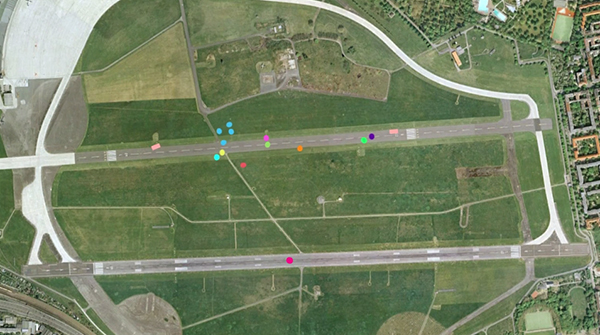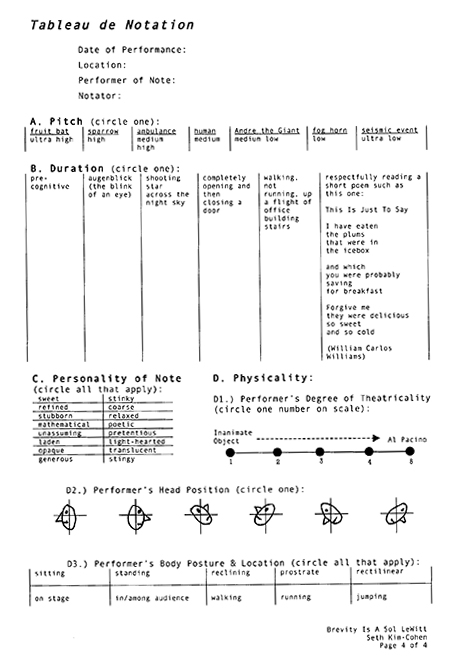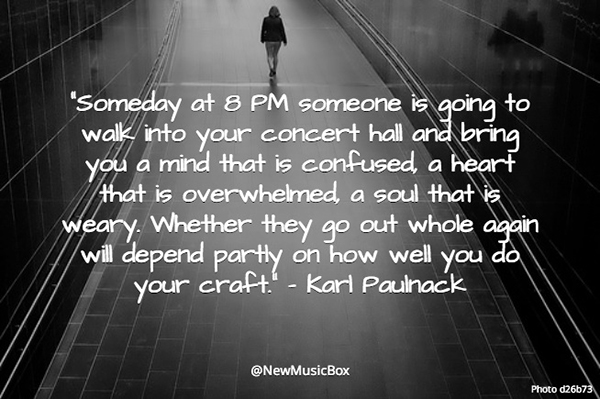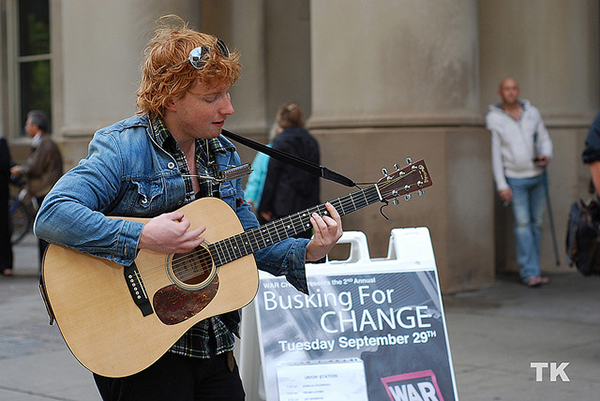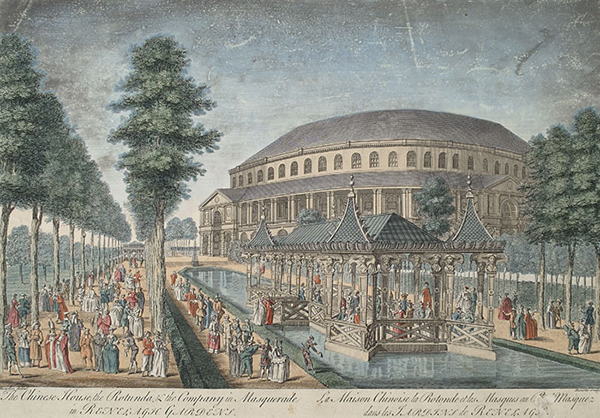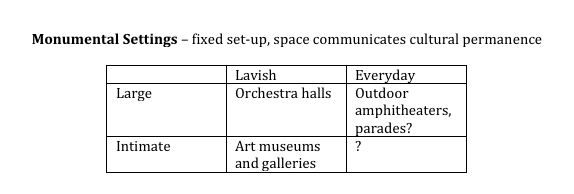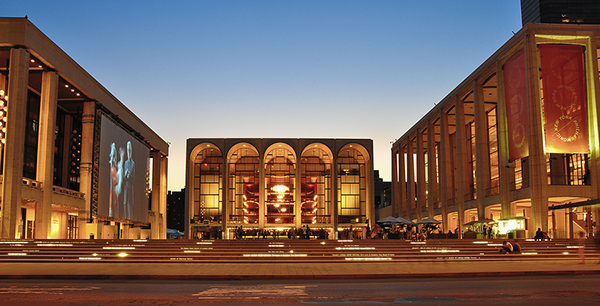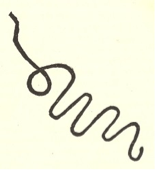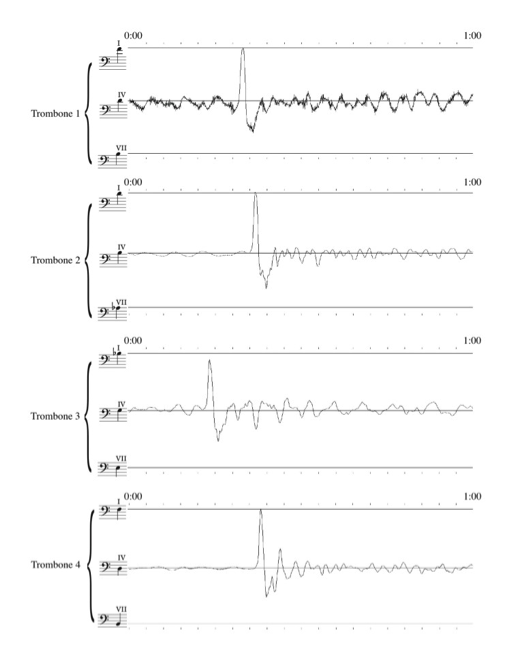At the composer’s home in New York City
November 18, 2013—2 p.m.
Transcribed by Julia Lu
Video presentation and text condensed and edited by Molly SheridanIt’s difficult to stand anywhere near composer and vocalist Lisa Bielawa and not feel energized by proximity. Her dynamic personality fires up a room, making it easy to see how, just a few weeks prior to our meet up for the interview posted below, she rallied hundreds of musicians for the performance of her massive outdoor work Crissy Broadcast on a repurposed airfield in San Francisco.
Raised in the Bay Area, Bielawa has recently returned to her hometown to serve as the artistic director of the San Francisco Girls Chorus, an ensemble she herself was once a member of as a young artist. Yet as a touring performer (in addition to her compositional activities, she has sung with the Philip Glass Ensemble since 1992), she began a kind of nomadic existence that continues to carry her from city to city. New York has been her primary address as an adult, but her music has also led to long stints in places such as Boston, where she was in residence with the Boston Modern Orchestra Project for three years; Berlin, where she mounted the first of the Airfield Broadcasts; and Rome where she was a fellow at the American Academy and produced a performance of a previous outdoor work, Chance Encounter, along the banks of the Tiber River.
An extrovert to the core, Bielawa acknowledges that her highly social nature has taken her in some specific directions both as a composer and as a musical citizen. Community building and close collaboration with performing artists is often central to her compositional process. In 1996 she co-founded MATA, a festival which allows young composers to celebrate other young composers outside of a competitive context. Yet the flip side of this outward focus is a deep love for language and careful reading that led her towards a bachelor’s degree in literature from Yale University and now continues to fuel her artistic output.
While there may be some unusual twists to her career trajectory and the scope and scale of her music, Bielawa is quick to point out that her path should not been interpreted as a rejection of traditional concert presentation or compositional education. She is focused on broadening the reach of new music, not completely rerouting it. And in the course of so doing, she is able to allow the sparks and energy of her ideas to fly.
*
Molly Sheridan: You began your career in a sense as a young singer with the San Francisco Girls Chorus, and now you’ve come full circle by returning to serve as the organization’s artistic director. As you listen to the students and reflect back on your own time there as a young performer, how much have things changed—both musically and culturally?
Lisa Bielawa: Before I actually, officially took over my position as the artistic director, the girls came to Berlin to participate in [my work] Tempelhof Broadcast. One of the reasons I got back in touch with them in the first place was that I was working on the project and wanted them to be a part of it. So that discussion started before any discussions about the new position began. I had been in West Berlin on tour with the chorus when I was a girl. It was the first time that I had ever left the country—I was 14 or something—and I remember thinking, “Wow, I really like being on the road!” Of course, apparently I really do like being on the road, because I’ve been on the road ever since.
It was really amazing to see the girls in Berlin and remember what it was like for me to travel with this group—making music with people and understanding that making music at a high level was one of the things that makes travel meaningful. That cultural exchange through music is something that especially young people are hungry for. I think the ambassadorial role that musicians have in the world is incredibly important—just listening and making sound for each other, creating work for each other and with each other across cultures. The world is much more interconnected than it was when I was in the Girls Chorus. Now you’ve got girls from San Francisco meeting host families in Berlin, and they’re still texting each other. But there’s no replacement for actually making music together physically and in community. There are many wonderful uses of social media and interconnectivity online, but music reminds us that engaging with each other face-to-face in space and in real time is irreplaceable. That’s what music making is.
MS: Your own compositional roots are also partially connected to the Girls Chorus in a special way.
LB: For a lot of girls who come through the San Francisco Girls Chorus, that’s where they start their music education. That wasn’t the case for me. I started my music education at home and, at the age of three, in the Suzuki violin program. I had musician parents, so the chorus is not where I got the beginning of my musical education. I got something really important that’s different from that, which is I individuated at the Girls Chorus.
At home, everyone was a composer. When my brother and I were little, we would write music at the piano, just sort of playing at what dad does. You know what that’s like—you play at what your parents do. So I had written music already when I got to the Girls Chorus, but I had experiences there which were my own. I’d come home to the dinner table, and I had had an experience with Brahms or something. It was the first time that I ended up having individual musical experiences that were emotional for me, and that started to build my own sense of what I wanted to hear and why that was. I started writing music that my friends and I could sing. Elizabeth Appling, who was the founder and the artistic director at that time, really fostered that. She saw that I was doing this with my friends and she started to program my music on our actual concerts. She had me conducting my own work at Davies Symphony Hall during the holiday concerts, and it was really the first time that I saw myself as a musician, the way that someone might see someone from the outside. I got a chance to have a witness outside of my family. That showed me that I was an individual artist, and that I had something to offer that was mine. So that was a really important training point for me.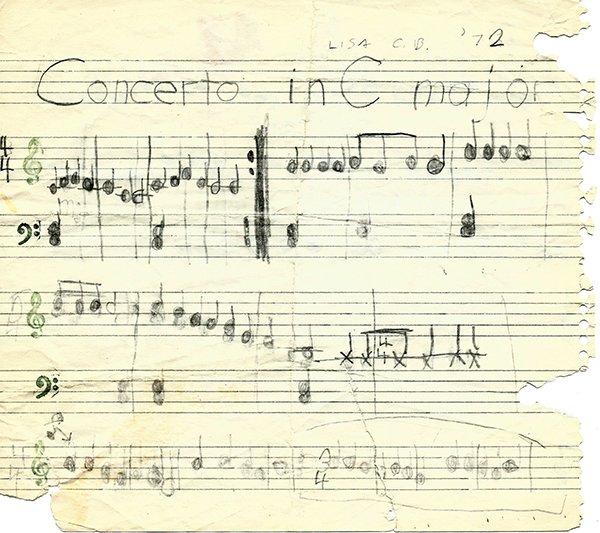
Early work composed at 4 or 5 years of age.
Then I went to Yale, and my very first commission was from the Girls Chorus. My second commission was from the Girls Chorus. That kind of training-wheel support went on. So it’s very meaningful to have it come back around now.
MS: I know that your actual degree from Yale was in literature. That might have been just a formality or perhaps not, but student composers often have a vision of how their education has to go. So when it goes somewhere different, I think it’s worth exploring the impact—both in terms of the big ideas and the practical skills.
LB: One of the things that I’ve actually started to say when I talk to people about this is that I really don’t want to be the poster child for DIY. I’m trained. I came from a family where there was formal training available at home. I trained on the violin. I trained on the piano. I trained vocally. I learned to read music in my mother’s church choir before I even read English. I did composition workshops at the summer music festivals in San Francisco. So to some degree, that means that I had already created a little body of work before I went to college.
My intention at Yale was to major in music and something else. The only thing you needed to do to take advanced classes in music at Yale was to be advanced enough in music to take them. I studied composition there and had private teachers as an undergraduate. I did all that stuff. However, I had gotten very interested in literature in high school, and here I was in the school of Harold Bloom! There was this incredible energy in the air, and all of the boys I had crushes on were literature majors. I was so turned on by the exchange of ideas that I felt you could have as a literature major. But what I discovered was that it was a very competitive major, and you couldn’t get into any of those classes if you were not a major. Plus, if you said you were a double major, then you were deemed not serious enough. In order to take advanced classes in literature and music, I had to major in literature.
So that’s the answer. I think there was a lot of pressure the entire time I was at Yale to major in music. I’m sure I probably fulfilled the major, but I just didn’t declare it. I think it was the right choice for me because I really got so much out of my studies in literature that wouldn’t have been open to me if I hadn’t declared that.
MS: Was that the end of your formal training then?
LB: Yes, it was. I moved to New York two weeks after [graduating from] Yale, and my intention was pretty vague. I had a friend who had graduated a couple of years before me who seemed to be getting some commissions in London. I was sleeping on sofas and basically trying to scrape together enough money to go to London or apply to graduate schools in something. I didn’t know what yet.
I knew I had musical skills, but when I was at Yale, I auditioned for voice lessons and didn’t get accepted. It’s a big opera school, and I didn’t have a big old opera voice. I had a different kind of voice. So I came to New York not really believing that I was a composer necessarily, and not really believing that I was a singer necessarily, but doing both well enough and in ways that were useful enough that I was making a living somehow, here and there, with also some administrative jobs and things like that. Then, through a series of flukes, I got the job with the Philip Glass Ensemble. I was 22 years old, and that totally changed my whole life.
MS: But it doesn’t sound like you were necessarily ready for that life.
LB: I had no idea. I didn’t have any indication from anyone else around me that I was a soloist. In fact, when I first got the job, they were just desperate to have somebody, and they probably would have hired someone more experienced with a more trained voice than mine if they had been able to. But who’s going to be available for a five-and-a-half-week tour in three weeks, except for someone who’s starving and 22?
So, I was really lucky in that I auditioned into that job on sight reading and rhythmic musicianship and the skill set that I had as a basic musician. As a singer, they weren’t so sure about me. And they shouldn’t have been. I was no great shakes as a singer yet. Once I got over the headiness of the first tour, I came to understand—and it was not very easy for me—that I had to get my act together. I had to get formal vocal training, which I basically had never had, or I was not going to keep my job. So I wasn’t an official member of the Philip Glass Ensemble until almost two years after I had started touring. They were actually looking at several people, and I was basically a sub until I could improve my abilities as a singer. It was a very difficult time, and expensive, too. It meant that my standard of living didn’t go up that much. I was getting platinum-style voice lessons and eating canned beans for dinner for the first year or so because I was just trying to catch up.
MS: But in the midst of all that high-pressure catching up and then the ongoing touring with Philip Glass, you still kept the composing going, too.
LB: That’s true, but again, taking myself seriously as a composer and/or as a singer? I knew that I was a musician, but it wasn’t clear to me, or basically anybody around me really, what I was. My brother, who’s 20 months older than I am, was at that time getting his doctorate in composition, and so my family was focused on my brother as a composer. Suddenly then we were kind of focused on me as a singer, but we were all a little surprised, I think. I had sung some of my father’s music as a soloist and when I was in the San Francisco Girls Chorus I got a few solos, but I was not one of the prized soloists in the group. I wasn’t really sure what I was.
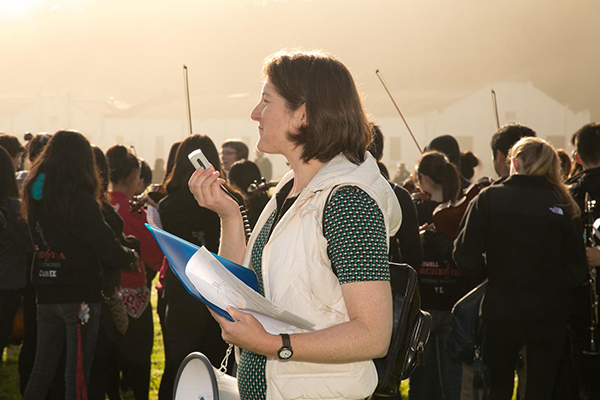
A singer, a composer, and definitely a leader.
Photo by James Block
I was writing music, but I didn’t think of myself as a composer necessarily until somewhere in my 20s. I wrote a piece for the San Francisco Girls Chorus that won the highest ASCAP young composer award and that completely took me by surprise. I had some people take me aside and say, “Look, maybe you’re a composer.” I just didn’t really understand yet—possibly because it was an over-populated environment. My family was over-populated with musicians, then I went into a school that was over-populated, and then I came to New York and was just trying to figure out how to be useful to make a living. I was always writing music, but it seemed like it was always the wrong kind of music. When I was at Yale, I was writing choral music, and I was writing cabaret songs, and I was writing arrangements of jazz standards for a cappella groups; I wasn’t writing serious music. So I just assumed that that meant I wasn’t a composer.
MS: Do you think not having a structured undergraduate music education, for all the reasons you outlined above, might have contributed to this in a certain way—as in, rather than your path in music being set out for you in clear formal terms, it was all on you to self-direct?
LB: It was all on me. But when I did study composition privately as an undergrad, I wasn’t really a very easy student. The irony is that now I feel very passionate about mentoring younger people. I love teaching, especially teenage composers. I’ve sort of specialized in that, but not because I had such a satisfying experience as a student. I was proud, and I was really independent-minded. I didn’t respond so well to somebody trying to guide me. I just didn’t.
MS: You said you like mentoring teenagers. It’s funny: You weren’t an easy student, and now you specialize in teaching perhaps the most challenging demographic.
LB: Well, teenagers are cool. Grad students are great, too, but they’re really colleagues already. They already have an ideological direction that they’re going in. You’re either going to feed into that ideological direction because you share that, or you’re going to butt up against it, and then you’re going to have to be arguing with your students.
I find that with teenagers, they’re all over the place. They’re discovering that they’re composers. They’re coming up with all these ideas, and they’ve got this fountain of musical energy. They’re complicated because their egos are also developing alongside their abilities in ways that they get ahead of themselves, or they’re super insecure, but there’s something about that sloppiness and about the fact that there’s personal development happening at the same time as musical development that I feel really prepared to deal with. I was writing music that young, too, and I remember what it was like to be trying to figure out who I was as a person at the same time that I was trying to figure out who I was as a musician. It was really an important part of my struggle. And I envied kids who were already cellists by the time they were 16 or who knew they were composers when they entered grad school. I didn’t have that luxury.
MS: You spoke some about how your voice wasn’t the right fit for Yale. A lot of your pieces have a soprano vocalist, but I was surprised to find out that those weren’t necessarily supposed to be sung by you. You were actually writing for a voice much different from your own.
LB: That’s true, although I will say that this spring I had two commissions, both of them European. One of them was for the Academic Male Choir of Helsinki. They wanted me as soprano soloist with this group—fifty men and me—and bass drum of course, because why not. Then there’s the piece for Radio France, which is for myself and chamber ensemble. I now feel ready and totally happy for that to happen. I know how to sing well enough so that I can actually find it interesting enough to write for myself.
First of all, the reason I got into vocal music was really more because of my relationship to language. It had very little to do with the fact that I was a singer. I was a singer because I had played all these instruments, but I didn’t have enough money to buy them. Your voice is free, and I had to make a living. How I became a professional singer was almost accidental and the kind of singing that I was doing—not just for Philip but for Toby Twining, who actually hired me even before Philip Glass did—my music is not like that, and I don’t use the voice that way so much in my own music. So I wasn’t really the right soloist for my music anyway. I wouldn’t have hired myself.
I’m also a collaborator. I just love to have the creative process be about getting to know others. That process is less interesting for me if it’s just me getting to know me some more. Though this last year, it’s been fun because I am finally finding things in my own voice. Something about being in my 40s, it’s like my voice is mature now. There are things it can do that are cool, that I’ve worked my whole life to figure out. I feel like I won’t have that forever, so it’s interesting to celebrate that. But my interest in writing vocal music had very little to do with being a singer. It had mostly to do with being close to language.
MS: We actually spoke at some length about your relationship to language almost a decade ago, just before the American Composers Orchestra premiered The Right Weather. Clearly you still take this aspect of your work very seriously. So why use music and not words exclusively in your creative expression?
LB: I love writing, but I also think one of the things that I love about writing is that it’s not my profession. So it’s a creative thing that I can deepen and that I can get better at, but I can also get away from it for a while and it doesn’t cause any anxiety. It’s nice to have an area that I’m deeply informed about, that I care deeply about, that’s not professionalized—because I have a lot of different areas of my life that are professionalized.
Then there’s also the fact that when I’m deeply moved by something that I read, usually my response is a musical one. So there’s something that happens that’s organic. I read on the sofa in the morning; if something is so beautiful to me that it makes me feel a certain way, that has to be resolved by sitting at the piano. That’s a way of working that when I have to start cranking out music and I’m on the road in practice rooms in universities, or writing music in hotels or on planes, I don’t always have that luxury—that deep cycle that involves contemplation, reading, responding to reading, and then composing. But if I don’t have that cycle every once in a while, then I lose my artistic ground.
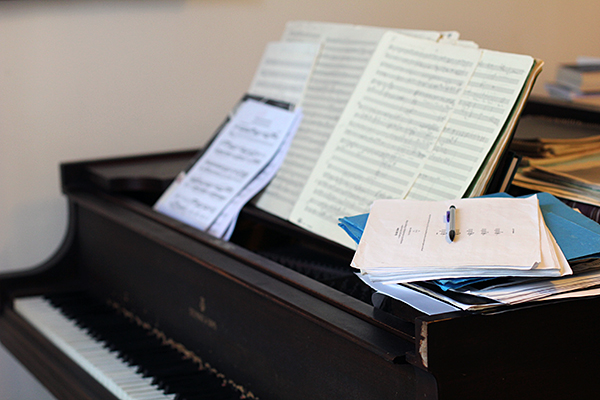
Bielawa’s Steinway
MS: That seems like a constant through the years with you. You drill down into text. This is not a surface feature—you began learning Russian to compare Pushkin translations! So what does that end up doing to the music in concrete terms?
LB: Making it possible? I remember when I was writing The Right Weather, and I was thinking, “God, I’m such a loser. I’m supposed to be writing for orchestra and there’s no language in this. I don’t know if I can write music if I don’t have language that I’m setting.” And then I thought, “Well, I don’t know. Maybe I am a loser; maybe I’m not a loser. But just because there are no voices singing here doesn’t mean that this is not connected to language.” I could either look at that as a crutch, or I could see myself in it and realize that that’s what it is. Some composers respond to nature. Some of them respond to paintings. Some of them respond to a number of things. It’s just the thing that hits me the most deeply and the most consistently. The place where I can find the most depth in myself is as a reader. So it helps me get to the place where I want to be when I’m writing music.
MS: You touched on collaboration and the importance of that in your work. I was thinking about this particularly as I was listening to your two-CD set In medias res, and I thought it might be good to talk specifically about your relationship with the Boston Modern Orchestra Project in this regard.
LB: The truth is I was actually quite scared of what my job was going to be in Boston, because the expectation was that I was going to be there for three years and was going to write these massive orchestral works. There was still a part of me that was like, am I a composer? Not for lack of ideas, but just something about the way I saw myself—or didn’t, or others did or didn’t. Who knows? Maybe it’s left over from the early years when I first came to New York. But I had people around me who had faith in me and who really wanted to see this happen, namely Gil Rose, who really believed in my music and felt that this would be an opportunity for me.
I wanted to make sure that I could keep myself on a schedule so that the piece that I wrote at the end of my residency, In medias res, would fulfill the potential of that. In order to do that, I decided that I would write these short, three- to five-minute Synopses—short pieces for solo members of the orchestra—and that I would write each of them during a week that I was in residence. Composers in residence seldom actually compose in residence, but I was going to write pieces when I was in Boston.
Of course, it was a pleasure, but it did force me to have a regular diet of engagement with the individual musicians for whom I was writing this much larger piece over a long period of time. And it meant that I was actually tilling the soil—not that I know anything about farming, but I was keeping that whole area of my mind and these relationships really fertile for the whole time. So when I was writing the big piece finally, which took me around seven months, I was informed by these 15 shorter pieces that I had written for the individual members of the orchestra.
That personalized it, and that was really helpful for me. Collaboration for me means that you’re beholding the amazingness of some other person and what they can do. Then I’m using my own abilities as a composer to make that shine or to engage with it. That’s a really great way to know people in the world, right? It deepened my connections with the musicians that I was working with, which heightened community in the orchestra itself. And it brought a sense of process to the audience there that was seeing these pieces unfold. So those are the kinds of ideas that I’ve designed for myself along the way—to keep myself on a schedule, but also to enhance community and therefore make composing less lonely and bring the vitality of interaction into the process in as many ways as possible. It’s helpful to me because I’m social and composing is not that social. I’m not really temperamentally cut out for this work, unless I can make it a little more social for myself.
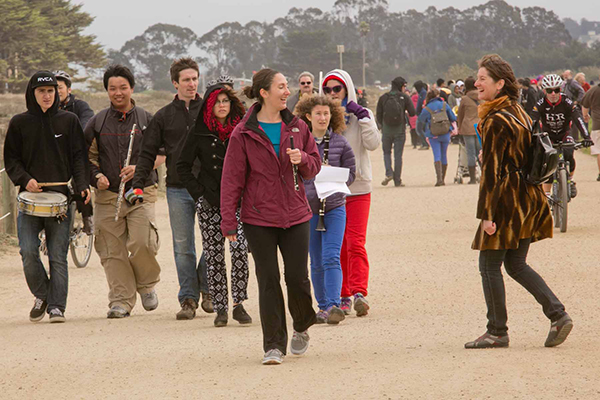
Bielawa greeting musicians at Crissy Broadcast
Photo by James Block
MS: Those Synopses then later ended up influencing a piece you did for a dance work, correct? And there are other examples of you developing ideas through multiple works. I thought that was really interesting: it wasn’t that all of your work was a piece of some single uber-arc, but each piece wasn’t always completely self-contained either. Would you speak some about what you hunt for and gain through that kind of occasional revisiting?
LB: I often think that it takes more than one piece to work through an idea. Individual compositions can get burdened down if you try to make them completely saturate or satiate one idea world in one piece. So I like to take the pressure off individual pieces. What if I had been working on one of the Synopses, let’s say, and the purpose at that point was for me to learn as much as possible about the harp and write something amazing for the solo harpist, right? But then later on, some of the material that I developed could, if the piece had gone a different way, maybe have been something really interesting to explore in relation to the human body through dance. I mean, I could just start over every time, and sometimes I do. It’s interesting looking back at pieces—did this come out of the germ of some other piece, or is this a whole new thing just by itself.
But generally what I find with shorter pieces is that I don’t actually feel very comfortable in small forms. I’m a large-scale person. So the only way that I can fulfill those kinds of commissions is to, at least in my own mind, embed them in some larger journey. Then it also ends up creating relationships that mean that those other pieces come along later. Some of these solo instrumentalists that I wrote the Synopses for were actually then the soloists in the dance piece. So it also brings the possibility of deepening those relationships and bringing them further. Many of the musicians that I’ve worked with I’ve written multiple pieces for in some guise or other. Look at Colin Jacobson, who’s been in, what, like nine or something? But they’re all different—just him, or sometimes there’s a whole orchestra, his string quartet. Sometimes I pair him with somebody like Carla Kihlstedt. And those relationships, as they deepen, I think that they really open me up, too, and help me find things through that trust that I would not otherwise find.
MS: What attracts you to the large-scale format with such intensity?
LB: I think it’s just a suitability thing—it’s my temperament. I admire Chopin enormously for the way that he was able to find a whole world in the solo piano works. He’s not here to answer, but we could ask ourselves, why didn’t he have a whole lifetime of writing symphonies or operas? He didn’t. This is what he wrote. It’s inconvenient for me sometimes that I end up wanting to write pieces for hundreds of musicians on an abandoned airfield. But it’s even more inconvenient to try to fit into certain assigned ways of making work that don’t fit. So I’ve accepted that I have to make it work for myself and the best way for me to do that is to go ahead and see things in terms of the larger picture and in terms of broader strokes—whether or not an individual performance or composition is seen that way. I need to see it that way in order to make it work for me and in order to make the best work I can.
MS: Before we get into those big airfield pieces and the musical communities you encourage through those, I want to take a step back. Because in a sense I see things such as the founding of MATA, which takes us all the way back to 1996, as another aspect of this big and social piece of your artistic life.
LB: Yeah, MATA. I really felt a need for it when we started it. I felt that there were all of these contexts in which I was coming into contact with my peers, but every time we came into contact with each other we were actually competing. I’d see so and so because we were two of the four finalists of the such and such thing. We would each have a piece read, and then one of us would win. Yeah, we would have fun and there would be a party, but underneath it all was the knowledge that somebody from on high was going to choose one of us.
There is this sort of protracted adolescence for composers: you get all your graduate degrees, and then you go to summer programs and you study with so and so. That’s another place where you can meet your peers, right? You’re all 31-year-old students of so and so, in like, Europe somewhere. And there may be value to that, too. I participated in both of those kinds of things and had some positive experiences. But why not support each other by having a festival where we all encounter each other’s music, and nobody was going to come and decide or teach. We don’t have to agree. You don’t have to like everything. Nobody’s the winner. I think that was a really driving motivation for me.
And that’s one of the reasons that, as I was nearing 40, I was feeling like I was not immersed enough and my ear was not to the ground as much as it needed to be to be MATA’s artistic director any more. All of a sudden, I was going to become the person on high who was choosing the commissionees for the festival. It was starting to turn into the thing that we were trying to be other than. So I’m still on the board and I’m very committed, but I cycled out and wanted to get younger people in charge. And we’ve really managed to do that, and I’m really super proud of that.
MS: So you shook things up some with MATA, but pieces such as Chance Encounter also gently stretch conventional ideas about how things are done. I love the degree that the venue is woven into the work itself, from finding the text to presenting the piece. But when you take your work out of the concert hall, how does it change the goals and impact of what you make? The loss of control seems like it becomes part of the point of the piece.
LB: Yeah, it’s funny. It’s like talking about the fact that I never got degrees in music. It doesn’t make me an anti-degrees-in-music person. I have nothing against the concert hall. I find myself so often in environments where people really want the fact that I do these public space works—which I’m very passionate about—to mean that I’m against the concert hall. That’s not true—I love the concert hall! These pieces are an affirmation; they are not a rejection. And that’s really, really important to me. I still have more to affirm outside the concert hall. They come out of the fact that I’m a very urban person. I think in my life I’ve been healed by city life. If I’ve gone through difficult times in my life, one of the things that I always know I can do to fall in love with humanity again is to just walk around the city. I’ve had this experience in San Francisco where I grew up, in New Haven where I was in school, in New York, where I’ve lived my whole adult life. Boston, Berlin, all the cities where I immersed myself.
That’s another thing besides reading and besides collaboration: urban life. That’s super important and inspiring to me. There are certain ideas that I have that make the most sense right there in the cradle of active urban life because that’s where my head is. Chance Encounter actually has Susan Narucki singing things that we overheard, so in order to write the piece, she and I had to immerse ourselves by eavesdropping on people for 14 months to collect all these things. There’s no better way to fall in love with humanity than to just go around the world and eavesdrop. So tender, the moments you hear.
Susan Narucki and I did a performance together of Birtwistle’s The Woman and the Hare. I feel like The Woman and the Hare is one of these pieces that if you were to stumble on it, just in the hall of your local community center, it would be a really arresting experience. She and I were talking afterwards, and she said, “I wish there were some way we could make work like this in an environment where people could just encounter it.” So it really came about as a collaborative light bulb. We thought we should make a piece that’s intended to be performed that way. It was only later as I was working on it that I decided to use overheard things. The idea was to have the kind of experience you have with concert works that I love, but to provide that outside in public space. And I’m not done with that.
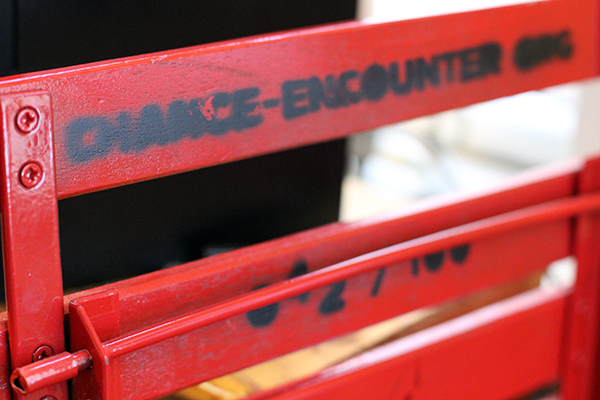
Souvenir chair from Chance Encounter
MS: You can’t really speak for the audience, but was the experience that you anticipated having ultimately the experience that you had when listening to the performance in this setting?
LB: I actually have to take the fifth because I have no idea. I have performed Chance Encounter, but my preferred role in the performance of these large-scale public space pieces is to just be like anybody and walk around. I like to put myself at a distance from everybody and feel myself in space. I like to change the arc of my own experience by moving towards or away from certain groups. And I notice that other people do that, too.
I certainly noticed that with Crissy Broadcast in San Francisco. There’s an overhead time-lapse video. There are the groups of musicians that stay together, but in the middle, there was just this constant latticework of people moving around. I heard responses from people that they were having this kind of awareness of being in a space where they were also integrating the sound of traffic and the dogs, and that’s part of it. The music has to sit comfortably in an environment where other sounds are also there. It has to feel mostly successful like that.
So I seem to be getting somewhere with it. I like working in that way. I feel like my experience of it has been sometimes different from what I imagined, but in a positive way. Or other times, it’s not what I thought and I was disappointed. But maybe I would go to the next performance, and the wind changes and then it’s what I hoped, or maybe it’s just that I was not standing in the right place; someone else had the experience that I had designed and imagined for myself.
MS: I guess that’s my question: how much can you even anticipate when you’re working on a scale like this and in an outdoor venue? There are so many wild cards. In some ways, maybe it’s not even possible.
LB: It’s absolutely not possible, but it’s not possible in any music. This is not the exception; this is just the obviation. I’ve heard from some people that they felt that by listening to these pieces, the Airfield pieces for example, that it brought them in touch with that existential thing: I’m always only me, and I’m always hearing what I’m hearing. Even though you’re out in public space, the experience of these pieces is one that’s very private and sometimes quite lonely. You realize that you’re an audience of one inside your own head, and that’s the human condition.
You were asking about the control that I think I have, or can have. There’s a lot of control going on in these pieces. It has to do with the fact that I’m dealing with amateurs and students. It has to be a safe performance environment for hundreds of people. I’m asking them to do some crazy things out there and it’s outside the box for everybody. It’s outside the box for the professionals! So contrary to what it may feel like when you’re out there in it, the listeners hopefully feel an amazing openness. But the actual compositional process has an enormous amount of control of material. If I set up a situation where this group is playing this or that, and there are some choices being made—aleatoric sections where maybe cues are being given from one group to another—I do actually try to imagine every possible way those things could work out using a kind of lay person’s game theory. I do try to imagine every possible outcome of every decision that I’ve allowed people to make in each section, and I have to be O.K. with the sonic result of every possible combination of decisions. If seven out of the nine decisions are going to be really cool, and two of them are going to sound really stupid, then I change the whole game. So there’s a lot of control.
MS: Even The Right Weather at Zankel Hall back in 2004 had you walking through the space and timing out planned musician movement, but I saw the charts you made for the Airfield pieces and this is a whole other level. How did you even begin structurally to make this work?
LB: Chance Encounter is a piece for one soprano and chamber orchestra in two different groups. So in that piece, I was able to experiment with what it means to have groups that are far enough away from each other that they can’t possibly be expected to play together, but they can respond to each other. I got the chance in five cities to experiment with different air densities and different winds, and to experiment with what kinds of sounds and what kinds of cues carried across space. So that was really important, because once I started bringing in more than just two groups, then at least I had that experience with communication between musicians across distances out in the real world—how to make rules, how much to tell them, how little to tell them.
When I started putting together Tempelhof Broadcast, the very first thing I did was work with The Knights again. They wanted me to write a piece for this concert that they did at Central Park in 2011. It coincided with my communications with the Berlin Parks Department, such that I realized that if The Knights were into it, I could use this commission to start working on some ideas, not about distance and space, like I did in Chance Encounter, but to work on some free, aleatoric decision making—large groups of musicians playing things that cue each other in such a way that there is no conductor. It’s 40 musicians or so, and it was a chance for me to experiment with some of these game structures where groups of musicians are communicating with other groups of musicians across the stage. So there were these intermediate steps.
With the Tempelhof Broadcast, frankly everything you do, you can’t really hide. You rehearse [on the field] and you’ve kind of done the piece, right? So in September of 2012, which was eight months before the premiere, we tried some of the sections with 50 musicians out on the field, and it was a way for me again to start experimenting with these large distances and these materials. So I gave myself a lot of experimental stages with this. By the time I got to between 230 and 250 musicians there, I was working with around six to eight different groupings; whereas in San Francisco for the Crissy Broadcast, I had 14 groups and 800 people. It’s like a balloon [being inflated] before the Thanksgiving Day parade gradually becoming Snoopy. It took, like, three and a half years for this balloon to fill. All along the way, I had to design the balloon with no air in it. So it was back and forth between an experiential and a conceptual process involving acoustic research that I did and collected from both parks departments. I took an alto saxophone and a pair of crash cymbals out on the runways and walked around with a pedometer learning about what carried. It was just a long and deep process, and that’s my favorite kind of process. So that graph [you asked about] was maybe the third or fourth solution that I found to write down the material that I had already been developing for months or years. I was just finding a way to represent it to myself, because a score was not going to work, and I finally found this way to use a multi-colored graph. It was in my hand the whole time; I had it in my hand for two months.
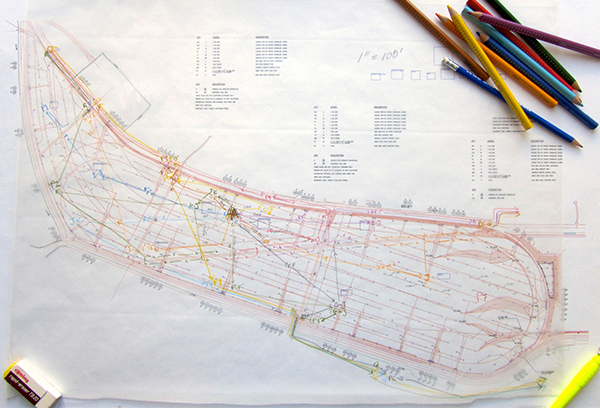
Charting out Crissy Broadcast
MS: Artistically, what is the point of 800 people on an airfield?
LB: It’s an acoustic decision. The artistic decision is the airfield. Eight hundred people is a pragmatic solution that has to do with no amplification. No amplification is an artistic idea that has to do with the fact that sound comes from a certain place. If you want to experience a space, one of the ways that you feel yourself in the space is if you hear the sounds coming from where they’re coming from. You hear a dog bark; it’s far away. It’s over there. If you heard that dog bark through quadraphonic speakers all over, then you’re no longer in a field. If I want to write music that celebrates a certain space, which I’m interested in, then the way to do that is to articulate the space honestly without manipulating it through amplification. Amplification is a way to erase a space and place another sonic space on top of it in such a way that you no longer feel the space.
So, in order to have an acoustic rendering of a space with human beings, you need hundreds of them. But the great thing about hundreds of them, which is an acoustic necessity, is that it happily brings in a whole other thing that I’ve become passionate about, which is celebrating the whole musical life of an urban area and shining light on all these other corners. Look what this middle school band director has been doing with so little funding for all these years with these amazing kids in the public school system! Check out this chorus that is organized through the Community Music Center in San Francisco of people from the various elder care centers! They have a chorus. That’s so cool. Turns out it was too cold out there for them to be there for my piece, but it’s really awesome.
That was something that was really effective in San Francisco. These hundreds of people—most of them middle school and high school kids—they encountered each other in this project and they were calling out to each other on a field, playing these signals to each other across space. There’s something very beautiful about it, and they really embraced it.
MS: So the piece had to be composed to suit amateur and student musicians?
LB: If you’re outside on a field, you have mezzo-forte and above available to you. The material has got to be declamatory. I wanted it to be joyful. There were some yearning moments, but I wanted declamatory, joyful, bold-colored shapes because that’s what works out there. And you know what? Middle school bands can play that. So can professionals. Everyone can play those things. I don’t need 800 super advanced contemporary music technicians to play this piece. Sometimes I do need them. I love virtuosity. This piece is not about virtuosity. This piece is about something else.
The fact that the model itself can be inclusive of performers at any level then touches something else that’s important to me, which is community. I need 800 people because it’s an airfield, and they can be at any level because the kind of material I need to write, many levels of musicians can in fact achieve together. And so it ends up being a natural fit.
MS: Are you satiated yet on these big pieces, or is this becoming something of a calling card?
LB: Steve Schick was my right-hand man out there in San Francisco. We were joking and he said, “After this, are you going to write a string quartet?” I don’t know! I’m of two minds. I absolutely love working on this project, but I don’t want it to be the only kind of thing I’m going to do for the rest of my life. I also really loved writing the Synopses, and I think those are good pieces. There’s an intimacy that I also need in my work that I may need to cycle back around to soon. But that doesn’t mean I’d be abandoning this forever either. I think the fact that my work sometimes goes in this direction where I’m interested in engaging community in these larger, bolder shapes out in these spaces, that’s a certain direction in my work, but it’s not the only direction. So I don’t think I’ll ever abandon it. I also think, God, are you kidding? If there are other airfields that are now public parks that have city agencies and music communities around them that want to do this, I am so game!

Bielawa in the thick of it at Crissy Broadcast
Photo by James Block
MS: Hopefully those airfields exist in a country where you already speak the local language.
LB: So I don’t have to keep learning languages. That’s so right.
MS: I am interested in how deeply passionate you are about community building. You yourself have lived in so many communities in sort of semi-longterm situations in the sense that you go in, deeply connect and make some precision drills, but then when the work is done, you move on.
LB: There’s a really specific thing that happens at the end of the Airfield Broadcasts. The groups go away from the center. By the end in San Francisco, there were 14 groups all around the perimeter of the park, and so the ones over here couldn’t even hear the ones over here. It was just too far away. And then in Berlin it was two, and in San Francisco there were three meeting points where these groups come together. There’s a small group of people that starts playing this little dancing phrase. They start playing that, and then most of the other groups around them join in with them—I wrote them all different parts that all go together, no matter when you enter—so there’s this big party that happens. In San Francisco, it’s like 200 people all doing that. Then some other group, like the Berkeley High School Band or something, shows up and plays something else completely unrelated and interrupts them. And they all stop.
But what you didn’t realize was that while this whole big party was going on, the original people who started playing that little dance-y thing, they snuck away. When the interrupters come and they all stop, [this small group] starts doing it again somewhere else and then they all go over there. This is happening in three separate places on the field inaudibly far from each other. This is exactly, I think, the poetry. There’s something so beautiful about that.
But that’s also kind of what I do, too. I want to go somewhere and I start a party. I get the party going. Then, when the party is at its fullest, I like to sneak away and start another party somewhere else. I wrote it into the piece, and I didn’t even realize I did that. I don’t know why that is. Leaving a party at its height—that’s heartbreakingly beautiful—and then you go somewhere else. That’s my role. I start fires, you know, and then I leave.




